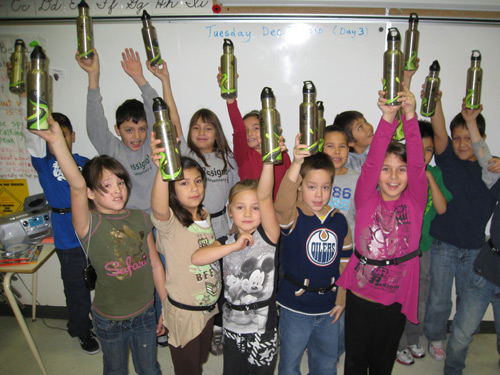Ile a la Crosse community and U of S researcher teach children healthy lifestyles
Children in Ile a la Crosse are playing more and learning to eat healthily thanks to a community-based research project led by University of Saskatchewan PhD student Sarah Oosman.
By Mark Ferguson Oosman, a community health and kinesiology researcher, worked with elders, teachers and community members to develop a set of lessons focusing on physical activity and nutrition for a grade 3-4 split class. This included in-class physical activity, nutrition and health lessons, along with five-minute physical activity flashcards with fun motions for the whole class to perform and family packs that reinforced the classroom lessons at home.
Oosman, a community health and kinesiology researcher, worked with elders, teachers and community members to develop a set of lessons focusing on physical activity and nutrition for a grade 3-4 split class. This included in-class physical activity, nutrition and health lessons, along with five-minute physical activity flashcards with fun motions for the whole class to perform and family packs that reinforced the classroom lessons at home.
"The whole program was developed to incorporate Métis culture, for example, using Michif Cree language. We wanted to do this in a way that was culturally appropriate and culturally relevant," Oosman said. Michif is the traditional Métis language, with roots in both Canadian French and Plains Cree.
Historically, Métis people were hunter-gatherers, which meant an active lifestyle and nutritious local food habits. Changes in the environment in which individuals live has led to a more sedentary lifestyle with a greater reliance on sweet and starchy processed foods, contributing to serious health challenges.
Among these is obesity, which can lead to life-threatening health complications such as Type 2 diabetes and heart disease. While this is a danger for people of all ages and backgrounds, Aboriginal populations are disproportionately affected.
Community- based research helps address health challenges with knowledge that the people themselves help to create. Not only did the children demonstrate healthy lifestyle changes, but their families made positive changes, too. The research team interviewed the parents to get an idea of how classroom lessons were translated at home.
"One of the families talked about how the messages sent home opened the environment to talk about pop drinking… and they completely stopped purchasing pop," Oosman said.
To help get the childrens' personal perspectives, the team used "photovoice," a research method that combines pictures and words. They encouraged them to take photographs of "Things You Eat" and "Things You Do," and explain why the images were important to them.
When the classroom program ended in December 2010, the class had more pictures of fruits and vegetables than they had when they started that September. A handful of students had even selected more culturally significant food subjects, like bannock and cranberries. As for things to do, the local playgrounds were a popular photo subject, reflecting both the childrens' increased interest in active play and the importance of the community's play-enabling equipment. Oosman said the community did a great job providing ways for people to be active.
"We found that a lot of the photos and interviews highlighted access to equipment like cross-country skis and skates," she said.
Just as encouragingly, the students in the healthy learning program kept just as active as weather got gloomy in winter. Normally as the temperature drops people spend more time watching TV, reading, or on their computers, but these students spent no extra time at these activities.
The Ile a la Crosse project was funded through the Indigenous Peoples Health Research Centre (IPHRC), which encourages community based and interdisciplinary Aboriginal health research. The funds paid for a variety of tools to test the effectiveness of the education program, from questionnaires to accelerometers to track the childrens' movements.
Oosman's work in Ile a la Crosse has already attracted national attention. In 2010, she was one of three recipients of the Scientific Director's Award of Excellence from the Canadian Institutes of Health Research Institute of Aboriginal Peoples' Health (CIHR-IAPH).
Note to media: Participants from the Ile a la Crosse healthy living community research project are available for interviews upon request to any of the contacts below.

